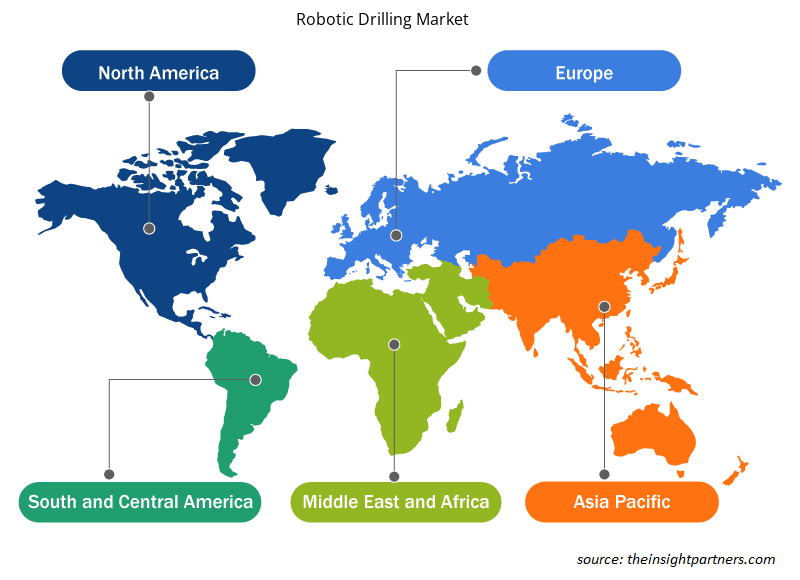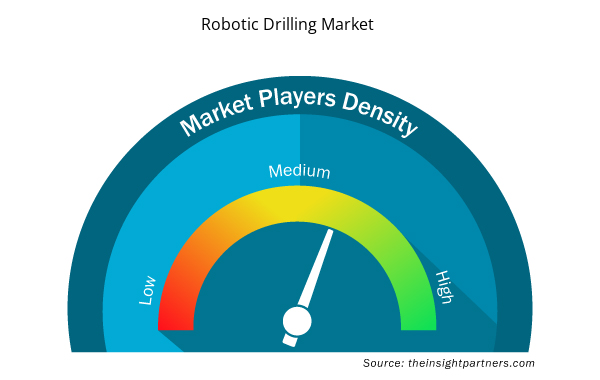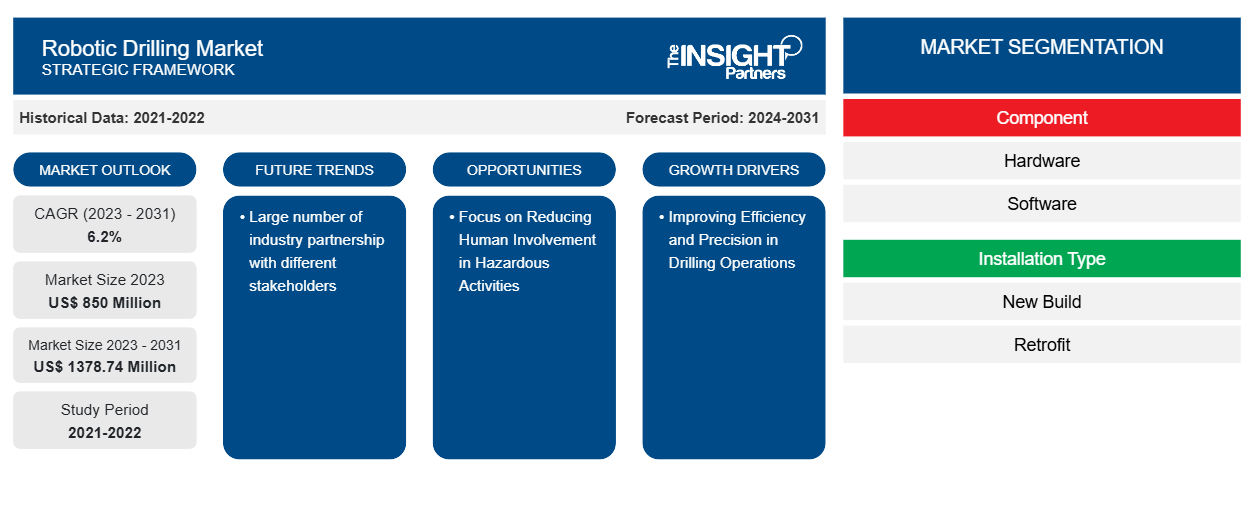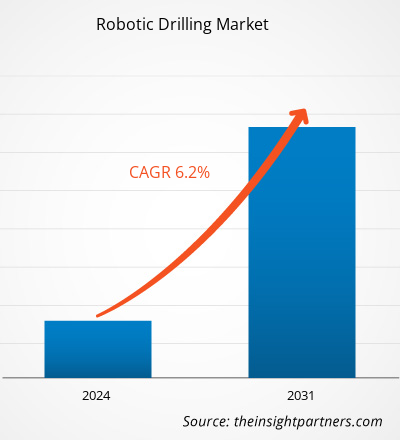من المتوقع أن يصل حجم سوق الحفر الآلي إلى 1378.74 مليون دولار أمريكي بحلول عام 2031 من 850 مليون دولار أمريكي في عام 2023. ومن المتوقع أن يسجل السوق معدل نمو سنوي مركب بنسبة 6.2٪ في الفترة 2023-2031. تعمل أنشطة الحفر المتزايدة في المقام الأول على دفع توسع السوق بسبب تطوير موارد الهيدروكربون الاستثنائية وتنفيذ الأتمتة والروبوتات في حفر النفط والغاز. وهذا يؤدي إلى كفاءة أعلى وتحسين سلامة الحفارات.
تحليل سوق الحفر الآلي
ومن المتوقع أن تؤدي أنشطة الاستكشاف المتزايدة، فضلاً عن التركيز على تطوير حقول النفط والغاز الجديدة بطريقة خالية من المخاطر وفعالة من حيث التكلفة والوقت، إلى دفع سوق أنظمة الحفر الآلية. ومع ذلك، فإن تقلب أسعار النفط في السنوات الأخيرة، ومخاوف الأمن السيبراني، وارتفاع تكاليف البدء، قد أعاقت نمو صناعة الحفر الآلية.
نظرة عامة على سوق الحفر الآلي
الحفر الآلي هو تقنية رائدة لعمليات الحفر المستقلة. تضمن أدوات التحكم في روبوت الحفر عمليات آمنة وفعالة مع تقليل الخطأ البشري. مع نمو السكان والمدن، أدى اعتماد العالم على الوقود الأحفوري إلى زيادة سريعة في الطلب على النفط والغاز. وقد أدى هذا إلى زيادة نشاط الحفر. يتزايد استخدام الحفر الآلي في استكشاف النفط والغاز، ومن المرجح أن تتوسع الصناعة بسبب زيادة التصنيع واستغلال احتياطيات الهيدروكربون غير التقليدية. ومن المتوقع أن يعزز توسع توليد الطاقة ، وخاصة في الاقتصادات الناشئة، نمو السوق. علاوة على ذلك، تعمل التطورات في تكنولوجيا الروبوتات كمحرك غير مباشر، مما يسرع مسار نمو سوق الحفر الآلي.
قم بتخصيص هذا التقرير ليناسب متطلباتك
ستحصل على تخصيص لأي تقرير - مجانًا - بما في ذلك أجزاء من هذا التقرير، أو تحليل على مستوى الدولة، وحزمة بيانات Excel، بالإضافة إلى الاستفادة من العروض والخصومات الرائعة للشركات الناشئة والجامعات
- احصل على أهم اتجاهات السوق الرئيسية لهذا التقرير.ستتضمن هذه العينة المجانية تحليلاً للبيانات، بدءًا من اتجاهات السوق وحتى التقديرات والتوقعات.
محركات وفرص سوق الحفر الآلي
تحسين الكفاءة والدقة في عمليات الحفر لصالح السوق
السعي الدائم لتحقيق الكفاءة التشغيلية والدقة في عمليات الحفر في مجموعة واسعة من الصناعات، بما في ذلك النفط والغاز والتعدين والإنتاج. تعمل أنظمة الحفر الآلية على تحسين الدقة وتقليل الأخطاء البشرية وزيادة الإنتاجية القياسية. العامل الأكثر أهمية في عمليات الحفر هو السلامة، حيث تعمل الهياكل الآلية على تقليل تعرض الإنسان للمواقف الخطرة، وخاصة في المناطق البحرية وفي التضاريس الصعبة.
التركيز على الحد من مشاركة الإنسان في الأنشطة الخطرة
للحد من تعرض البشر لسيناريوهات الحفر الخطرة، تعطي الشركات الأولوية للسلامة وتخفيف المخاطر في قطاع الحفر الآلي. تعتمد عمليات الحفر التقليدية، وعادةً ما تكون الصناعات مثل استكشاف النفط والغاز والتعدين والبناء، على العمال البشريين لأداء المهام التي تتطلب مجهودًا بدنيًا ومحفوفة بالمخاطر. جعلت تقنية الحفر الآلي عمليات الحفر أكثر أمانًا وأمانًا، مما أدى إلى تحويل المشهد التجاري. يقلل الحفر الآلي من الحاجة إلى مشاركة البشر في أنشطة الحفر الخطرة. غالبًا ما يتم تنفيذ هذه العمليات في أماكن صعبة أو نائية، مثل المناجم الخطرة أو منصات النفط البحرية أو منصات أعماق البحار.
يواجه الموظفون في هذه المواقف مخاطر مختلفة، بما في ذلك الحوادث والتعرض للمنتجات السامة والطقس القاسي. يمكن للشركات استخدام معدات الحفر الآلية لتقليل المخاطر وتحسين سلامة الموظفين.
تقرير تحليل تجزئة سوق الحفر الآلي
إن القطاعات الرئيسية التي ساهمت في اشتقاق تحليل سوق الحفر الروبوتي هي المكون ونوع التثبيت والتطبيق.
- وفقًا للمكون، يتم تقسيم سوق الحفر الروبوتي إلى أجهزة وبرامج.
- حسب نوع التثبيت، يتم تقسيم السوق إلى بناء جديد وتحديث
- من ناحيةمن حيث التطبيق، يتم تقسيم السوق إلى سوق برية وسوق بحرية.
تحليل حصة سوق الحفر الآلي حسب المنطقة الجغرافية
ينقسم النطاق الجغرافي لتقرير سوق الحفر الآلي بشكل أساسي إلى خمس مناطق: أمريكا الشمالية، ومنطقة آسيا والمحيط الهادئ، وأوروبا، والشرق الأوسط وأفريقيا، وأمريكا الجنوبية/أمريكا الجنوبية والوسطى. وبسبب تطوير الغاز الصخري مؤخرًا في أمريكا الشمالية، فقد نما سوق معدات الحفر الآلي بشكل كبير. كما تتزايد عمليات الاستكشاف في خليج المكسيك، وهو ما يقود سوق أنظمة الحفر الآلي الإقليمية. وقد أدت تكاليف الحفر المنخفضة المرتفعة وأسعار النفط إلى زيادة كبيرة في عدد الحفارات البحرية وإنتاج النفط في الولايات المتحدة، مما يشير إلى توسيع الحفر البحري، والذي من المتوقع أن يكون محركًا رئيسيًا لسوق الحفر الآلي في البلاد.
رؤى إقليمية حول سوق الحفر الآلي
لقد قام المحللون في Insight Partners بشرح الاتجاهات والعوامل الإقليمية المؤثرة على سوق الحفر الآلي طوال فترة التوقعات بشكل شامل. يناقش هذا القسم أيضًا قطاعات سوق الحفر الآلي والجغرافيا في جميع أنحاء أمريكا الشمالية وأوروبا ومنطقة آسيا والمحيط الهادئ والشرق الأوسط وأفريقيا وأمريكا الجنوبية والوسطى.

- احصل على البيانات الإقليمية المحددة لسوق الحفر الآلي
نطاق تقرير سوق الحفر الآلي
| سمة التقرير | تفاصيل |
|---|---|
| حجم السوق في عام 2023 | 850 مليون دولار أمريكي |
| حجم السوق بحلول عام 2031 | 1378.74 مليون دولار أمريكي |
| معدل النمو السنوي المركب العالمي (2023 - 2031) | 6.2% |
| البيانات التاريخية | 2021-2022 |
| فترة التنبؤ | 2024-2031 |
| القطاعات المغطاة | حسب المكون
|
| المناطق والدول المغطاة | أمريكا الشمالية
|
| قادة السوق وملفات تعريف الشركات الرئيسية |
|
كثافة اللاعبين في سوق الحفر الآلي: فهم تأثيرها على ديناميكيات الأعمال
يشهد سوق الحفر الآلي نموًا سريعًا، مدفوعًا بالطلب المتزايد من المستخدم النهائي بسبب عوامل مثل تفضيلات المستهلكين المتطورة والتقدم التكنولوجي والوعي المتزايد بفوائد المنتج. ومع ارتفاع الطلب، تعمل الشركات على توسيع عروضها والابتكار لتلبية احتياجات المستهلكين والاستفادة من الاتجاهات الناشئة، مما يؤدي إلى زيادة نمو السوق.
تشير كثافة اللاعبين في السوق إلى توزيع الشركات أو المؤسسات العاملة في سوق أو صناعة معينة. وهي تشير إلى عدد المنافسين (اللاعبين في السوق) الموجودين في مساحة سوق معينة نسبة إلى حجمها أو قيمتها السوقية الإجمالية.
الشركات الرئيسية العاملة في سوق الحفر الروبوتي هي:
- بيكر هيوز
- شلمبرجر
- هاليبرتون
- كاتربيلر
- بئر النفط الوطني فاركو
- أطلس كوبكو
إخلاء المسؤولية : الشركات المذكورة أعلاه ليست مرتبة بأي ترتيب معين.

- احصل على نظرة عامة على أهم اللاعبين الرئيسيين في سوق الحفر الآلي
أخبار سوق الحفر الآلي والتطورات الأخيرة
يتم تقييم سوق الحفر الآلي من خلال جمع البيانات النوعية والكمية بعد البحث الأولي والثانوي، والتي تتضمن منشورات الشركات المهمة وبيانات الجمعيات وقواعد البيانات. فيما يلي قائمة بالتطورات في السوق:
- وفي مارس/آذار 2021، حصلت شركة شلمبرجير على عقد بقيمة 480 مليون دولار أميركي لحفر 96 بئراً نفطية في جنوب العراق لصالح شركة نفط البصرة وإكسون موبيل، اللتين تديران حقل غرب القرنة 1 الضخم مع شركاء من العراق واليابان وإندونيسيا والصين.
(المصدر: موقع شركة شلمبرجير الإلكتروني، 2021)
- في أكتوبر 2021، كشفت شركة Nabors Industries Ltd عن منصة الحفر الأرضية الآلية بالكامل PACE-R801 والمزودة بالروبوتات Canrig. وقد حققت عمقًا كاملاً مع أول بئر لها في حوض بيرميان. كما صممت أرضية منصة مستقلة للتخلص من الأطقم من مواقع المنطقة الحمراء وتوفير أداء حفر ثابت.
(المصدر: شركة نابورز إندستريز المحدودة، موقع الشركة الإلكتروني، 2021)
تقرير سوق الحفر الآلي والتغطية والمخرجات
يوفر تقرير "حجم سوق الحفر الروبوتي والتوقعات (2021-2031)" تحليلاً مفصلاً للسوق يغطي المجالات التالية:
- حجم السوق والتوقعات على المستويات العالمية والإقليمية والوطنية لجميع قطاعات السوق الرئيسية التي يغطيها النطاق
- ديناميكيات السوق مثل المحركات والقيود والفرص الرئيسية
- الاتجاهات المستقبلية الرئيسية
- تحليل مفصل لقوى PEST/Porter الخمس وSWOT
- تحليل السوق العالمي والإقليمي الذي يغطي اتجاهات السوق الرئيسية واللاعبين الرئيسيين واللوائح والتطورات الأخيرة في السوق
- تحليل المشهد الصناعي والمنافسة الذي يغطي تركيز السوق، وتحليل خريطة الحرارة، واللاعبين البارزين، والتطورات الأخيرة
- ملفات تعريف الشركة التفصيلية
- التحليل التاريخي (سنتان)، السنة الأساسية، التوقعات (7 سنوات) مع معدل النمو السنوي المركب
- تحليل PEST و SWOT
- حجم السوق والقيمة / الحجم - عالميًا وإقليميًا وقطريًا
- الصناعة والمنافسة
- مجموعة بيانات Excel


- Automotive Fabric Market
- Antibiotics Market
- Legal Case Management Software Market
- Print Management Software Market
- Artificial Intelligence in Healthcare Diagnosis Market
- Hair Extensions Market
- Sexual Wellness Market
- Small Molecule Drug Discovery Market
- Pipe Relining Market
- Saudi Arabia Drywall Panels Market

Report Coverage
Revenue forecast, Company Analysis, Industry landscape, Growth factors, and Trends

Segment Covered
This text is related
to segments covered.

Regional Scope
North America, Europe, Asia Pacific, Middle East & Africa, South & Central America

Country Scope
This text is related
to country scope.
الأسئلة الشائعة
The global robotic drilling market is expected to reach US$ 1378.74 million by 2031.
The key players holding the majority of shares in the global robotic drilling market are Baker Hughes, Schlumberger, Halliburton, Caterpillar, and National Oilwell Varco.
A large number of industry partnerships with different stakeholders to play a significant role in the global robotic drilling market in the coming years.
Improving efficiency and precision in drilling operations are the major factors that propel the global robotic drilling market.
The global robotic drilling market was estimated to be US$ 850 million in 2023 and is expected to grow at a CAGR of 6.2% during the forecast period 2023 - 2031.
Trends and growth analysis reports related to Electronics and Semiconductor : READ MORE..
The Insight Partners performs research in 4 major stages: Data Collection & Secondary Research, Primary Research, Data Analysis and Data Triangulation & Final Review.
- Data Collection and Secondary Research:
As a market research and consulting firm operating from a decade, we have published and advised several client across the globe. First step for any study will start with an assessment of currently available data and insights from existing reports. Further, historical and current market information is collected from Investor Presentations, Annual Reports, SEC Filings, etc., and other information related to company’s performance and market positioning are gathered from Paid Databases (Factiva, Hoovers, and Reuters) and various other publications available in public domain.
Several associations trade associates, technical forums, institutes, societies and organization are accessed to gain technical as well as market related insights through their publications such as research papers, blogs and press releases related to the studies are referred to get cues about the market. Further, white papers, journals, magazines, and other news articles published in last 3 years are scrutinized and analyzed to understand the current market trends.
- Primary Research:
The primarily interview analysis comprise of data obtained from industry participants interview and answers to survey questions gathered by in-house primary team.
For primary research, interviews are conducted with industry experts/CEOs/Marketing Managers/VPs/Subject Matter Experts from both demand and supply side to get a 360-degree view of the market. The primary team conducts several interviews based on the complexity of the markets to understand the various market trends and dynamics which makes research more credible and precise.
A typical research interview fulfils the following functions:
- Provides first-hand information on the market size, market trends, growth trends, competitive landscape, and outlook
- Validates and strengthens in-house secondary research findings
- Develops the analysis team’s expertise and market understanding
Primary research involves email interactions and telephone interviews for each market, category, segment, and sub-segment across geographies. The participants who typically take part in such a process include, but are not limited to:
- Industry participants: VPs, business development managers, market intelligence managers and national sales managers
- Outside experts: Valuation experts, research analysts and key opinion leaders specializing in the electronics and semiconductor industry.
Below is the breakup of our primary respondents by company, designation, and region:

Once we receive the confirmation from primary research sources or primary respondents, we finalize the base year market estimation and forecast the data as per the macroeconomic and microeconomic factors assessed during data collection.
- Data Analysis:
Once data is validated through both secondary as well as primary respondents, we finalize the market estimations by hypothesis formulation and factor analysis at regional and country level.
- Macro-Economic Factor Analysis:
We analyse macroeconomic indicators such the gross domestic product (GDP), increase in the demand for goods and services across industries, technological advancement, regional economic growth, governmental policies, the influence of COVID-19, PEST analysis, and other aspects. This analysis aids in setting benchmarks for various nations/regions and approximating market splits. Additionally, the general trend of the aforementioned components aid in determining the market's development possibilities.
- Country Level Data:
Various factors that are especially aligned to the country are taken into account to determine the market size for a certain area and country, including the presence of vendors, such as headquarters and offices, the country's GDP, demand patterns, and industry growth. To comprehend the market dynamics for the nation, a number of growth variables, inhibitors, application areas, and current market trends are researched. The aforementioned elements aid in determining the country's overall market's growth potential.
- Company Profile:
The “Table of Contents” is formulated by listing and analyzing more than 25 - 30 companies operating in the market ecosystem across geographies. However, we profile only 10 companies as a standard practice in our syndicate reports. These 10 companies comprise leading, emerging, and regional players. Nonetheless, our analysis is not restricted to the 10 listed companies, we also analyze other companies present in the market to develop a holistic view and understand the prevailing trends. The “Company Profiles” section in the report covers key facts, business description, products & services, financial information, SWOT analysis, and key developments. The financial information presented is extracted from the annual reports and official documents of the publicly listed companies. Upon collecting the information for the sections of respective companies, we verify them via various primary sources and then compile the data in respective company profiles. The company level information helps us in deriving the base number as well as in forecasting the market size.
- Developing Base Number:
Aggregation of sales statistics (2020-2022) and macro-economic factor, and other secondary and primary research insights are utilized to arrive at base number and related market shares for 2022. The data gaps are identified in this step and relevant market data is analyzed, collected from paid primary interviews or databases. On finalizing the base year market size, forecasts are developed on the basis of macro-economic, industry and market growth factors and company level analysis.
- Data Triangulation and Final Review:
The market findings and base year market size calculations are validated from supply as well as demand side. Demand side validations are based on macro-economic factor analysis and benchmarks for respective regions and countries. In case of supply side validations, revenues of major companies are estimated (in case not available) based on industry benchmark, approximate number of employees, product portfolio, and primary interviews revenues are gathered. Further revenue from target product/service segment is assessed to avoid overshooting of market statistics. In case of heavy deviations between supply and demand side values, all thes steps are repeated to achieve synchronization.
We follow an iterative model, wherein we share our research findings with Subject Matter Experts (SME’s) and Key Opinion Leaders (KOLs) until consensus view of the market is not formulated – this model negates any drastic deviation in the opinions of experts. Only validated and universally acceptable research findings are quoted in our reports.
We have important check points that we use to validate our research findings – which we call – data triangulation, where we validate the information, we generate from secondary sources with primary interviews and then we re-validate with our internal data bases and Subject matter experts. This comprehensive model enables us to deliver high quality, reliable data in shortest possible time.


 احصل على عينة مجانية لهذا التقرير
احصل على عينة مجانية لهذا التقرير